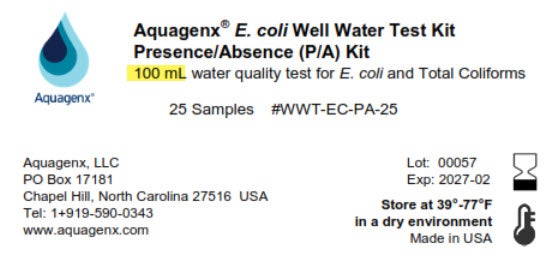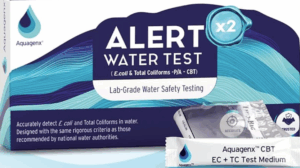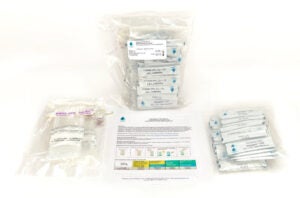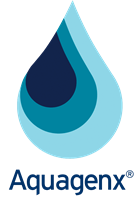Reason for 100mL Samples In Water Quality Testing
The water that residential and commercial properties receive from a regulated public water system (PWS) is analyzed for safety according to U.S. federal regulations. Routine testing mandates for bacteria according to the U.S. EPA Revised Total Coliform Rule are:
- Collect and analyze 100mL (milliliter) sample
- Test for the presence or absence of Total Coliform bacteria (bacteria commonly found in the environment)
- If test results reveal the presence of Total Coliforms, additional samples are required to specifically detect the presence or absence of E. coli bacteria (fecal bacteria found in intestines and feces of humans and warm blooded animals)
The greatest bacterial waterborne risk to health are fecal pathogens (disease causing organisms). Additional testing for E. coli bacteria is required because E. coli is the more specific indicator of fecal (from poop/stool) contamination in water than Total Coliforms.
Private well owners are not regulyed by PWS or local health agencies. they are responsible for testing their own well water to make sure it is safe to drink. Well owners can send their samples to a lab for analysis, and the lab analyzes 100mL samples.
Well owners can also purchase DIY well water tests online or in home improvement stores. Not all of these DIY tests analyze 100mL samples, but they should.
Why EPA Says 100mL Water Sample
Why does the EPA specify a 100mL sample of water, which is approximately 3.38 fluid ounces? The reason for 100mL sample volumes was determined by massive scientific and public health research.
 In the first half of the 20th century, scientists studied the presence of pathogens in water that cause Typhoid Fever. Typhoid is transmitted by Salmonella Typhosa (S. Typhosa) bacteria that live in the intestines (gut) of infected people and can contaminate food and water. These scientists looked at the ratios of coliform bacteria to S. Typhosa in water and wastewater.
In the first half of the 20th century, scientists studied the presence of pathogens in water that cause Typhoid Fever. Typhoid is transmitted by Salmonella Typhosa (S. Typhosa) bacteria that live in the intestines (gut) of infected people and can contaminate food and water. These scientists looked at the ratios of coliform bacteria to S. Typhosa in water and wastewater.
They also looked at the health risks of Typhoid Fever that occurred in waterborne outbreaks in which concentrations of coliform bacteria and S. Typhosa were both quantified (measured or counted). They estimated health risks and made recommendations on water volumes to analyze.
Based on this and related work, the 100mL volume became the standard volume for analysis of water samplea. 100mL likely contains the true population of bacteria in a water sample, enough to determine the health risk with high reliability. Scientists concluded that a 10mL volume is too small and might pose a greater than acceptable exposure risk to S. Typhosa. A 1,000mL volume was considered too large, impractical and too complex for testing.
Since that time, 100mL volumes for water testing of E. coli and other bacteria have been required and mandated by the U.S. EPA and the World Health Organization (WHO). The 100mL sample volume provides the most accurate volume level to determine the actual health risk of drinking water for fecal bacteria and other harmful pathogens in water.
Why Testing a Lower Sample Size is Deficient
 There must be a sufficient numbers of E. coli bacteria in water samples so it is detectable in analysis. If you only use 1mL or 5mL tests – or any volume below 100mL – they do not detect enough E. coli in the relevant range to determine the safety of drinking water. A 100mL sample ensures the likelihood you will capture enough bacteria, specifically E. coli bacteria if they are present.
There must be a sufficient numbers of E. coli bacteria in water samples so it is detectable in analysis. If you only use 1mL or 5mL tests – or any volume below 100mL – they do not detect enough E. coli in the relevant range to determine the safety of drinking water. A 100mL sample ensures the likelihood you will capture enough bacteria, specifically E. coli bacteria if they are present.
Using below 100mL volume tests increase the liklihood of obtaining false negative test results for Coliforms and E. coli bacteria. A false negative for bacteria in water testing occurs when a test does not detect the presence of bacteria, even if they are present in the sample.
Why take this risk? It is far better to test your drinking water for safety according to EPA and well as World Health Organization specifications for drinking water.
How to Know DIY Tests Analyze 100mL Samples
When shopping online for bacterial well water testing kits, carefully read the product specifications. They should include the sample volume size or link to instructions for how to use the test that specifiy 100mL samples.
Key Terms
Public Water System: federally regulated entity provides water for human consumption through pipes or other constructed methods of moving water
Total Coliforms: large group of bacteria commonly found in the environment
E. coli: fecal bacteria found in intestines and feces of humans and warm blooded animals
Fecal: refers to human or animal poop/stool
Pathogens: organisms that cause disease
False Negative Test Result: false negative for bacteria in water testing occurs when a test does not detect the presence of bacteria, even if they are present in the sample
Aquagenx Well Water Test Kits
P/A test results for E. coli and Total Coliforms, 100mL samples
Distinguishes between E. coli and Total Coliforms
Simple test, color change test results easy to interpret
No labs or electricity required
Room temperature incubation at 77° Fahrenheit and above
Room temperature test results in 20-48 hours
Three year shelf life of E. coli growth medium when stored properly
Buy on Amazon & Walmart
Buy kits that contain 2, 5, or 10 tests

Buy In Bulk from Aquagenx
Buy kits that contain 25, 50 or 100 tests

